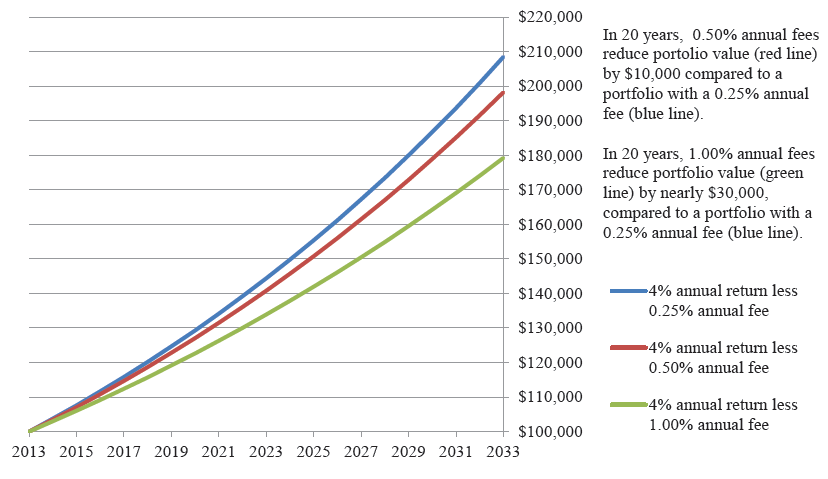What are Mutual Fund Expense Ratio and Fees
Post on: 24 Май, 2015 No Comment

A mutual fund represents money contributed by multiple investors. That money is managed by an individual, or more likely, a whole slew of individuals. Not surprisingly, those folks who help manage and oversee your money do not do it on a volunteer basis. They get paid. Do you want to guess who pays them? You do through fees assessed by the mutual fund that you pay. When you look at the mutual fund prospectus, the mutual fund is required to disclose all its fees. In addition, they will include a chart that shows you how the expenses and fees would impact a $1,000 investment.
Remember, fees are not inherently bad . But, there are many people who think this is one of many problems with mutual funds . The mutual fund company does need to pay for the cost of overseeing your money. Exorbitant fees can cut deeply into your potential profit. You should also remember that all mutual fund companies charge fees and they simply adjust or allocate the fees in different ways – often with the hope of making you think you’re not paying any fee.
Expense Ratios
The expense ratios is the most common fee and it consists of two main components.
Management Fees
The management fees cover the cost of overseeing your investments. They help pay for everything from computers, to mailings, to salaries. Just think big offices and high overhead, and you know where this percentage of your money is going.
An average expense is between 0.25% and 1.5%. Most people suggest investors avoid funds that have fees over 1.5%. My personal feeling is that if you are paying a higher management fee, but you are getting better returns, then the expense fees really do not matter.
12B-1 Fees
Typically if a fund does not charge a load, you can expect that they have a higher 12B-1 fee. This fee covers advertising and marketing. Since the mutual fund company did not offer a load to a financial advisor to encourage you to purchase from them, they now use the investor’s money to try and get more investors.
Loads
A load is a sales commission paid either when you buy the mutual fund or when you sell it. When the sales commission is added at the time you purchase the fund, it is called a “front-end load ”. Not surprisingly, when the commission is added upon selling, it is called a “back-end load ”. Load payments typically end up in the hands of brokers or sales agents. I left my previous financial advisor because he could not recommend something without a load.
The biggest problem with a load is it automatically limits how much of your money will be working to increase your gains.
Hidden Load Fee
When a mutual fund does not charge a load but then charges a higher 12b-1 fee, this is called a hidden-load fund. They are not technically charging you a load, but they are making the same amount of money by restructuring their fees. As always, due diligence by the investor is necessary.
Exit or Redemption Fees
These are fees charged when you sell your shares. The fees may be a flat rate or a percentage. In order to discourage short term trading some funds will have a mandatory minimum holding period. If you sell before that time frame you can expect to pay their specified fee. Other companies encourage you to hold their funds by scaling the fees back year after year.
For example, if you sell after year 1, you pay a 5% fee. If you sell after year 2, it is 4%. Year 3 = 3%. Year 2 = 2%. Year 5 = 1%. Year 6 + you pay no fee.
Brokerage Fees
It is important to remember that all the fees listed above are fees charged by the mutual fund company. Your broker might also charge additional fees. These fees might be annual fees, purchase fees per mutual fund, and their own short term trading fees. Thus, in addition to researching the mutual fund fees you must also be familiar with the fees imposed by your brokerage. You will need to find the best investment brokerage for mutual funds .
As with every investment, it is essential that you know and understand the fees. Even within a mutual fund type you can have different share types (A, B, C) each with their own fee structure. You must have a personalized investing plan and then choose shares that have the lowest fees according to your plan.
Because of all of the fees associated with mutual funds, some investors prefer index funds. These funds typically have very small fees (less than 1%). Either, way if you are a beginning investor it is important to do some preliminary research before you start investing.
To help you minimize mutual fund fees, I encourage you to try out Personal Capital. This excellent free software can help you see exactly how much money you spend each year on fees, allowing you to trade out expensive mutual funds and ETFs and exchange them for lower cost ones.














